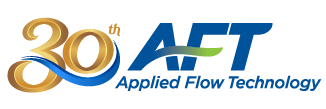AFT Blog
AFT flow modeling software allows you to easily change system line-up by closing junctions and pipes. How you take a portion of a system out of service affects what calculated results are available in output. Let's take the case where we have a valve, pipe, heat exchanger, pipe and valve in sequence. To close one of the valves we can either open its specifications window, select the Optional tab and check 'Special Condition / Closed' or simply click the valve junction to select it then click the Special Condition button on the toolbar. A red "X" will appear next to the...
AFT software supports ISO and English units and provides a variety of ways to select the units to be used. For example, in the Output window you can change units 'on the fly' for a specific parameter by double clicking an output column header and selecting the desired unit from the Change Units window. To globally change the unit system, go to the Options menu and select Parameter and Units Preferences. Select the Unit Preferences tab, choose the Default Unit System then click the Apply Default Units button. This will both apply the default units for the selected unit system and...
To choose only English or SI units, go to the Options menu, select Parameter & Unit Preferences, then the Unit Preferences tab. Choose the Default Unit System then click the Apply Default Units button. This will set the units to be used both on input and output windows.
A variety of resistance modeling methods are available within AFT software, including constant or variable K values for a wide variety of components, K or Cv for valves. Also, for most components, you may directly model a resistance curve. This is especially handy when you pressure drop (or head loss) vs. flow data from the component manufacturer or test data. Whether you're modeling a valve, spray discharge, orifice or general component junction, you'll find this option on the Loss Model tab of the junction specification window listed as "Resistance Curve". Clicking the button will highlight an 'Enter Curve Data' button, which...
AFT software has a variety of features for editing and navigating around models. One of these is the ability to define and then easily jump to bookmarks. So, what are bookmarks? A bookmark is an identified location, a junction or pipe, within a model. To create a bookmark, select a junction or pipe by clicking it once. On the View menu, select Bookmarks\Set Bookmark. To jump to the bookmark, simply press F9 and the Workspace will pan to bring the junction or pipe into view and select it. Any number of bookmarks may be defined. When multiple bookmarks are set, pressing...
You've probably modeled pumps using curve data from the manufacturer. In conjunction with specifying a name reflecting the pump make and model and saving pumps to your component database, selecting and using these pump junctions in your system models is fast and easy. Often, however, a make/model pump will have not one set of head/pressure, efficiency and NPSHR curves, but a family of curves for various operating speeds and impeller diameters. You could define a pump junction for each set of curves, but with Multiple Pump Configurations, you can readily save the entire family of curves in one pump junction. For...
Users regularly contact us asking for information to assist them in validating AFT software. The formality of the validation requirement ranges from customer's self imposed internal requirements to rigorous validation as required for work in the nuclear industry. Fortunately, AFT provides extensive reference material for validation and, what's more, you probably already have it since it's automatically installed when you install AFT Arrow, AFT Fathom, AFT Impulse or AFT xStream. Under the main application folder you'll find the Verification folder, containing models developed from published references. The source of the reference problem is displayed in the General section of the Output...

